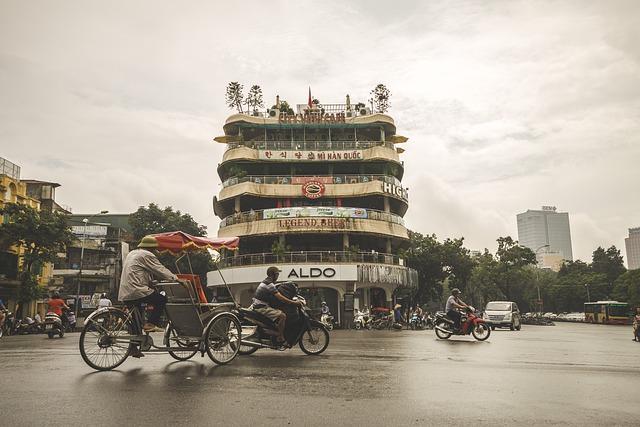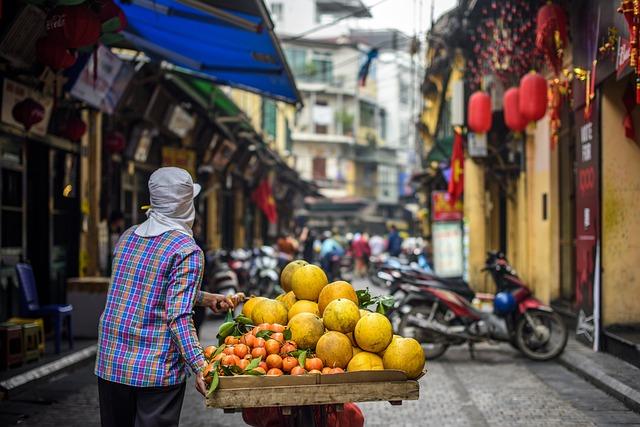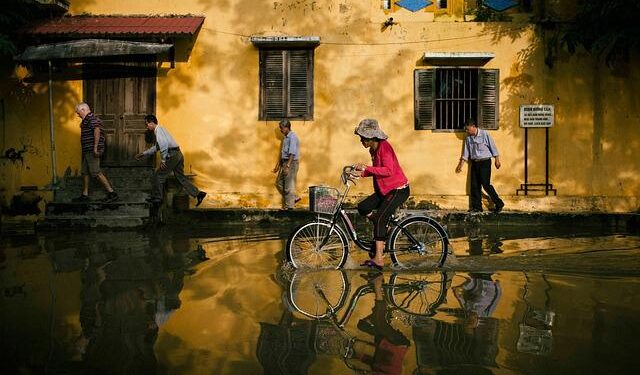Hanoi,Vietnam – The capital city of Hanoi is grappling with severe flooding as the swollen Red River overflows following the devastating impact of Typhoon Yagi,which has claimed the lives of at least 179 individuals across the region.Heavy rains and high winds associated with the storm have wreaked havoc, inundating streets and disrupting daily life in the urban landscape. With rescue and recovery efforts underway, authorities are facing the daunting task of managing the aftermath of this natural disaster, while residents are left too navigate the challenges posed by rising water levels and potential health risks. As the region confronts the immediate crisis, questions about infrastructure resilience and disaster preparedness loom large, prompting urgent discussions about the ongoing effects of climate change in Southeast asia.
Impact of Typhoon Yagi on Hanoi’s Infrastructure and Economy
The devastating impact of Typhoon Yagi has left profound scars on Hanoi’s infrastructure and economy. Flooding across the city has caused significant damage, as the swollen Red River overflowed its banks, inundating residential and commercial areas. key transportation routes, including roads and bridges, suffered severe erosion and blockages, leading to widespread disruption. the aftermath has revealed the vulnerability of the city’s drainage systems,which struggled to cope with the record rainfall,highlighting the pressing need for infrastructure improvements. Local authorities have initiated emergency assessments to gauge the extent of damage, aiming to prioritize repairs and ensure the safety of citizens.
Economically, the effects of the typhoon are expected to be far-reaching. Many small businesses, particularly those in the retail and food sectors, faced immediate losses due to flooding and electricity outages. In addition, agricultural activities in surrounding regions have been severely hindered, as crops were either washed away or left to rot in waterlogged fields, threatening food security and livelihoods. The following factors illustrate the economic challenges ahead:
- Infrastructure damage: Extensive repairs needed for roads, bridges, and public transport.
- Business Interruptions: Closure of shops and services leading to decreased revenue.
- Agricultural Losses: Significant crop damage affecting local farmers.
- Health Risks: Increased potential for waterborne diseases complicating recovery efforts.
| sector | Estimated Loss (USD) |
|---|---|
| Infrastructure Repairs | $50 million |
| retail sector | $20 million |
| Agriculture | $30 million |

Emergency Response Efforts in the Aftermath of the Flooding
In response to the catastrophic flooding that has gripped Hanoi following Typhoon Yagi, local and national authorities have initiated a multi-faceted emergency response plan aimed at mitigating further damage and providing immediate assistance to affected residents. Key efforts include:
- Evacuation Centers: Temporary shelters have been established in schools and community centers to accommodate displaced families.
- Relief Supplies: Emergency kits, including food, water, and medical supplies, are being distributed to vulnerable populations.
- Infrastructure Assessment: Teams are on the ground assessing damage to roads and public utilities to facilitate repairs and restore essential services.
Moreover, collaboration among government agencies, non-governmental organizations, and international relief groups has been instrumental in addressing the immediate needs of those affected.The following table summarizes the response efforts underway:
| Agency/Organization | Role | Assistance Provided |
|---|---|---|
| Central Government | Coordination | Funding and resources allocation |
| Local authorities | On-the-ground Support | Evacuation and shelter management |
| NGOs | Humanitarian Aid | distribution of food,clothing,medical aid |

Assessment of Humanitarian Needs and Displacement Concerns
The recent devastation in Hanoi following Typhoon Yagi has raised urgent concerns regarding the humanitarian and displacement needs of affected citizens. With the river swelling beyond control, significant portions of the city have been submerged, leaving thousands displaced and in dire situations. Many families have lost their homes, prompting local authorities and humanitarian organizations to assess the immediate needs and provide assistance. Key concerns identified during initial evaluations include:
- Access to clean water and sanitation: Flooded areas face contamination risks, necessitating immediate supply distribution.
- Food security: Disruption of local markets and supply chains has created shortages, requiring emergency food aid.
- Healthcare access: With hospitals overwhelmed and services interrupted,urgent medical care is critical for those impacted.
- Shelter and housing support: Rapid response is needed to provide temporary shelter for displaced families.
The scale of displacement has resulted in a significant humanitarian crisis that requires coordinated efforts to address immediate needs. As assessments continue, local leaders have begun to prioritize the restoration of infrastructure and the provision of essential services. A preliminary overview of the situation highlights the urgency of response efforts:
| Need | Priority Level | Estimated Impact |
|---|---|---|
| Clean Water | High | 1 Million affected |
| Food | High | 500,000 affected |
| Healthcare | Medium | 200,000 needing care |
| Shelter | high | 300,000 homeless |
As relief efforts unfold,humanitarian agencies are calling for donations and volunteer support,reinforcing the critical need for collaborative solutions to navigate through this harrowing situation and restore hope in the affected communities.

Long-Term Solutions for Flood Mitigation in Vulnerable Regions
To effectively address the perennial challenge of flooding in regions like Hanoi, a comprehensive approach is essential. Long-term solutions must incorporate both structural and non-structural measures.For instance, investments in green infrastructure can help to absorb excess rainfall and reduce runoff. Implementing policies that protect and restore wetlands can enhance natural water retention, while afforestation in upstream areas will minimize soil erosion and sediment buildup. Additionally, constructing sustainable drainage systems can facilitate the efficient management of stormwater during peak flood events.
Community engagement is another critical component of effective flood mitigation strategies. Education and training programs for local populations on flood preparedness can substantially enhance resilience. Moreover, establishing local task forces dedicated to disaster response can foster quicker action during emergencies. Other essential strategies include:
- Infrastructure upgrades: Reinforcement of levees and embankments.
- Urban planning reforms: Implementing land-use policies that avoid construction in flood-prone areas.
- Real-time monitoring systems: Deploying technology to track rainfall and water levels.

Community resilience and Recovery: Support Systems for Affected Families
The aftermath of Typhoon Yagi has highlighted the urgent necessity for a robust support network geared towards assisting families impacted by the flooding in Hanoi. Local community organizations, along with government agencies, are mobilizing resources to provide essential services to affected households. Key initiatives being implemented include:
- Financial Aid: Immediate monetary assistance to families struggling to meet daily expenses.
- Counseling Services: Mental health support for those coping with trauma and loss.
- Housing Assistance: Temporary shelters for families who have lost their homes.
- Food Distribution: Provision of essential food supplies to ensure no one goes hungry during recovery.
Furthermore, community resilience relies heavily on volunteer networks and local businesses stepping in to offer aid. Grassroots efforts are being established to foster collaboration among residents, ensuring sustainable recovery practices are emphasized.A recent initiative saw volunteers come together to form recovery teams that assist in:
| Recovery Initiative | Description |
|---|---|
| Neighborhood Cleanup | Mobilizing residents to clear debris and restore public spaces. |
| Resource Exchange | Facilitating the exchange of goods and services within the community. |
| Skill workshops | Offering training sessions to empower residents with new skills. |
These coordinated efforts are critical in rebuilding not just the physical infrastructure, but also the social fabric of Hanoi as communities come together in the face of adversity.
Editorial Recommendations for Policymakers and Disaster Preparedness Strategies
The recent devastating floods in Hanoi resulting from Typhoon Yagi underscore the critical need for effective disaster preparedness strategies. Policymakers must prioritize the development and enhancement of resilient infrastructure that can withstand extreme weather events. Key recommendations include:
- Investment in Enhanced drainage Systems: Upgrading existing drainage systems to accommodate heavier rainfall and prevent urban flooding.
- Community Education and Preparedness Programs: Implementing widespread education initiatives to ensure residents understand flood risks and preparedness measures.
- Early Warning Systems: Improving technologies and communication channels to ensure timely alerts about impending disasters.
- Collaborative Response Strategies: Establishing partnerships between government agencies, NGOs, and community leaders to coordinate disaster response and recovery efforts.
Furthermore, it is essential that environmental considerations shape policy decisions. encouraging the restoration of natural flood plains and wetlands can definitely help mitigate flood damage while providing ecological benefits. A table summarizing best practices for risk reduction could include:
| Strategy | Description |
|---|---|
| Land Use Planning | integrating flood risk assessments into urban planning processes. |
| Infrastructure Resilience | Design structures to withstand severe weather impacts. |
| Flood Forecasting | Utilizing advanced meteorological data to predict flood events. |
| Public Awareness Campaigns | Engaging communities through knowledge sharing and preparedness drills. |
Wrapping Up
the aftermath of Typhoon Yagi serves as a stark reminder of the vulnerability of urban centers like Hanoi in the face of natural disasters. With the death toll rising to 179 and extensive flooding affecting thousands, the impact of this catastrophic event is profound. Efforts are underway to assess the damage and provide relief to those affected, but the challenges ahead remain significant.As authorities and communities grapple with the consequences, the need for enhanced disaster preparedness and resilient infrastructure is more urgent than ever. The events surrounding Typhoon Yagi underscore the importance of a coordinated response and the necessity for ongoing support for recovery initiatives in the region.















